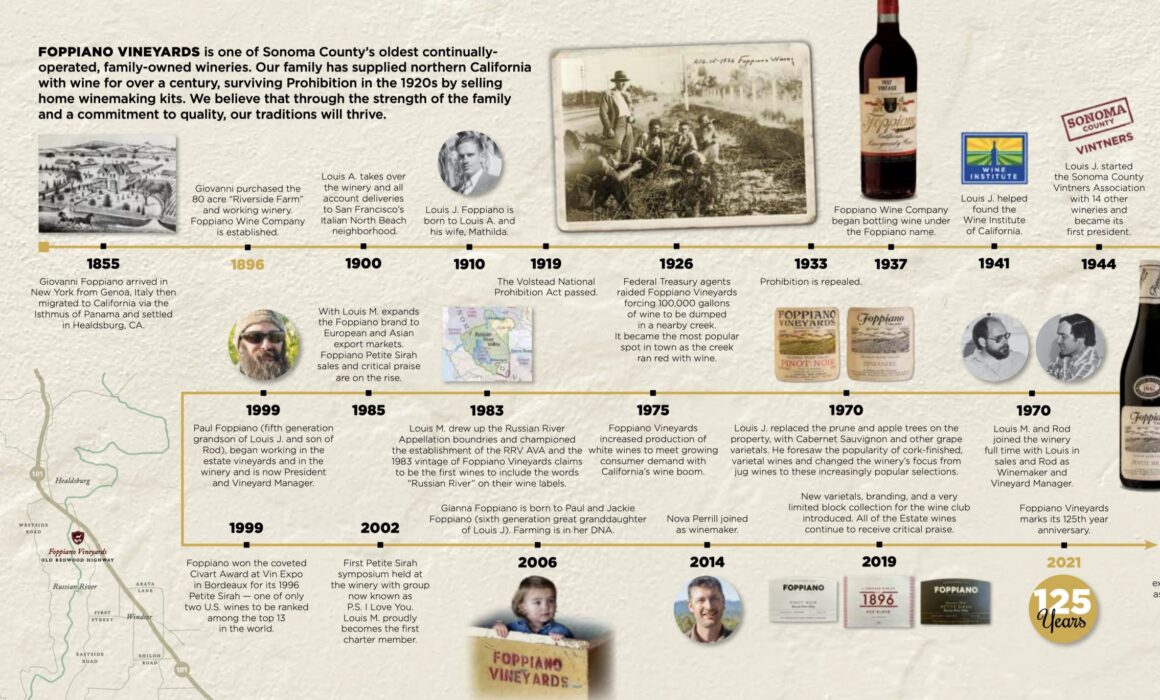100 Years in Sonoma County
By Virginie Boone
California joined the United States in 1850, meaning we’re not even 200 years old. So it’s remarkable to think that Sonoma County has farms and ranches that have been in business for a century or more.
Serres Ranch is one of them. It is celebrating its 100th year as a Sonoma Valley ranch this year, on its sixth generation of farming its land.
John Pierre Serres – also known as Toots – came to San Francisco in 1872, moving up to Sonoma County in 1924 to the present-day site of Serres Ranch, set along Highway 12 between Agua Caliente and Glen Ellen.
Several members of the fifth generation of the family, including Taylor Serres Murnig and her father John Pierre and brother Buck, continue to live and work on the 200-acre ranch, farming 130 acres of wine grapes and producing a great line-up of estate-grown wines.
The Serres also run an organic cattle business between Sonoma Valley and another 5,000-acre ranch in Mendocino County, where they farm 20 acres of sought-after blueberries, and have a construction business, run by oldest brother John Marshall. The blueberries, in addition to being sold fresh, go into a canned grape and blueberry wine called Bleusé.
Between 1851 and 1857, the Serres land belonged to General Joseph Hooker (often referred to as “Fighting Joe”) and called Hooker’s Ranch or Hooker Oaks. When Hooker took off to fight the Civil War, he sold his ranch to George Watriss, a famous hotelier from New York City who had opened the Astor House luxury hotel. Serres and Watriss knew each other for decades before Serres fully acquired the land.
It took until the fourth generation of Serres for wine grapes to enter the equation, with the help of Jim Bundschu of Gundlach Bundschu Winery in Sonoma. Bundschu’s own family history dates back as far. Family patriarch Charles Bundschu came to San Francisco in 1862 from Germany eventually meeting Jacob Gundlach, who had already planted a sizable vineyard he called Rhinefarm outside of the town of Sonoma. Bundschu joined on in 1868. Bundschu eventually married Gundlach’s daughter Francisca, and a legacy brand was born.
While portions of the original holdings were replanted to pears during Prohibition, or sold off, some of the earliest plantings of European vines planted at Rhinefarm produced grapes for nearly a century, until they were replanted on St. George rootstock in 1969 by Jim Bundschu. A few years later, he produced the first wines off the site, and Gundlach Bundschu was reborn. His children, Jeff and Katie, represent the sixth generation of family leadership.
Farther north on Highway 12 from Serres is Pagani Ranch, planted to head-trained Zinfandel in the early 1900s by Angela and Felice Pagani. Felice oversaw the Goldstein Ranch on Moon Mountain for many years – before it became Monte Rosso – and bought these 25 acres of field blended vines from a San Francisco judge, eventually adding more acreage to get to 55. Dino Pagani Amantite, representing the fourth generation, farms it today, selling the grapes to marquee producers such as Bedrock, Carlisle and Ridge.
Mark Sanchietti is a fourth-generation grapegrower; his family put down roots on Irwin Lane in West Sonoma County in 1919, growing prunes, walnuts and poultry until Prohibition passed and farming wine grapes was viable again. They survived selling fruit in San Francisco for many years during World War II. Mark’s father Mel farmed the family property but also ran vineyard operations at Korbel Winery for 35 years. Mark and his wife Jenny founded Sanchietti Farming as a continuation of the family business.
Up near Healdsburg, Foppiano Vineyards was founded in 1896 (and first called Riverside Farm) by Italian immigrant Giovanni Foppiano, and it continues to be run by members of the Foppiano family today, including fifth-generation member Paul Foppiano, who serves as president and vineyard manager; his young daughter represents the sixth generation.
The family survived Prohibition by selling their grapes to home winemakers. There’s an incredible moment of Foppiano history described in the 2009 book, “When The Rivers Ran Red: An Amazing Story of Courage and Triumph in America’s Wine Country,” by Vivienne Sosnowski.“A trickle of dark liquid began to flow, slowly at first; hesitating a little, and then with a deep-throated roar it became a torrent so mighty it was as if the heavens themselves had been ripped open… the small crowd of men, women and children who stood watching was stunned into silence… as thousands upon thousands of gallons of liquid began to stream past their feet into a great ditch that ran alongside the Foppiano’s vineyard.”
Indeed 100,000 gallons of Foppiano wine were dumped by Federal Treasury agents in 1926 during the height of Prohibition. Among the family’s enduring legacies is helping found the Wine Institute of California and Sonoma County Vintners Association and championing the Russian River Valley AVA.
Also in Russian River Valley, the Martinelli family started farming in the 1880s, planting grapes, most famously Zinfandel, well before Prohibition. Giuseppe Martinelli planted Jackass Hill by horse and plow on a 60-65 degree hillside unfathomably steep by today’s measure. It is run by the fourth generation of farmers who descend not only from the Martinelli family but also the Charles, farmers on the Sonoma Coast since the 1860s.
In Dry Creek Valley, Pedroncelli Winery dates back to 1927 (nearing the century mark) and to Giovanni and Julia Pedroncelli, who started out with 25 acres of Zinfandel and a barn once used as a winery called John Canota, built in 1904. The Pedroncellis survived Prohibition, like so many others, by selling grapes to home winemakers. The family still farms one acre of its original Zin.
In the 1940s they started their own label with second-generation John Pedroncelli Jr. making the wines and by 1954 they were among the first to put Sonoma County on their labels. In 1966 the family planted the 6-acre Wisdom Vineyard on West Dry Creek Road to Cabernet Sauvignon. When the third generation of Pedroncellis took over ownership of the business in 2010, it became 70% woman-owned.
Across the way in Alexander Valley, Peter Young came to California lured by the Gold Rush, buying a ranch in the Sonoma County region in 1858.
Starting out with 210 acres of prunes, third-generation Robert Young in 1963 was the first in Alexander Valley to plant Cabernet Sauvignon, and became as well-known for his Chardonnay, propagating Clone 17, or what is now known as the Robert Young clone. Robert’s son Fred founded Robert Young Estate Winery in 1997 with his three siblings, JoAnn, Susan and Jim. The fourth generation is now also involved.
All of these families across different pockets of Sonoma County survived not only Prohibition, but phylloxera, two world wars, the Great Depression, an American population just learning about wine, changing consumer preferences, and so much more. It takes a lot to make it to 100.
Has your family ranch, vineyard or winery made it 100 years? Get in touch. We hope to continue these stories in upcoming installments.


